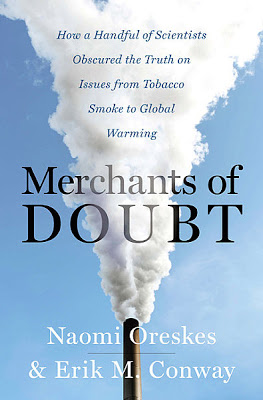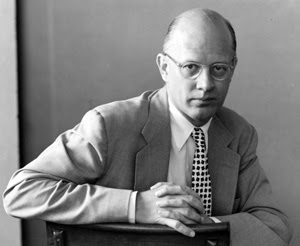
Merchants of Doubt:
How a handful of scientists
obscured the truth
Naomi Oreskes and Erik Conway uncover the history of a small group of Cold War scientists and advisers who battled anything, including scientific research, that might threaten their vision of American free enterprise.
By Christine Shearer / Truthout / June 15, 2011
[Merchants of Doubt by Naomi Oreskes and Erik Conway (Bloomsbury Press, 2011). Reprint Edition, Trade Paperback, 368 pp., $18.]
Merchants of Doubt is a very well-researched book about a small group of scientists and scientific advisers to the U.S. government who transitioned from their role as Cold War warriors supporting nuclear weapons to ideologically-motivated “contrarians” battling anything they saw as a threat to liberty and free enterprise, even if that meant the science on acid rain or the hole in the ozone layer.
While many books have looked at the misinformation campaigns around issues such as tobacco and climate change, Oreskes and Conway take it one step further, locating some of the key players in multiple issues and situating them as products of a particular history: defenders of the American way of life against its perceived enemies, whether it be communists and socialists or environmentalists and science.
The authors are well-suited for the task as both are historians of science — Oreskes at UC San Diego and Conway at NASA’s Jet Propulsion Laboratory. They bring together considerable evidence to support the argument that a very small group of people has been particularly influential in shaping U.S. public opinion and policy on a number of very important issues.
Oreskes and Conway particularly focus on physicists Fred Seitz, Fred Singer, and William Nierenberg, as well as a few other contrarian scientists, many of them connected to the politically conservative think tank, the Marshall Institute.
The book starts off by describing the efforts of some of these scientists in support of nuclear weapons and, eventually, the Strategic Defense Initiative (SDI) proposed by U.S. President Ronald Reagan in 1983, to strike down nuclear ballistic missiles in the air.
The book examines how these efforts split the scientific community between those pushing for the phasing out of nuclear weapons (such as the Union of Concerned Scientists, founded in 1969) and the “political hawks” like Nierenberg and Singer who favored nuclear weapons and thought SDI was not only feasible but necessary for U.S. dominance.
Oreskes and Conway lay out how the latter began to see those opposing the proliferation of nuclear weapons as traitors playing into Soviet hands. This set the stage for the contrarian crusade against science that threatened their worldview, from insisting that SDI was feasible (despite all evidence to the contrary, with SDI eventually derided by many in the U.S. as “Star Wars”), to challenging the research on nuclear winter.
The book then looks at how this small group of scientists went on to battle the scientific consensus on a number of issues, including the effects of acid rain, the hole in the ozone layer, the dangers of cigarette smoke, and the existence of anthropogenic climate change.
The authors also present some of the revisionist arguments against Rachel Carson‘s Silent Spring (1962), showing how contrarians are casting doubt on even supposedly settled issues such as the harmful effects of the synthetic pesticide DDT, as part of a broader attack on the legitimacy of the environmental movement and government regulation.
With all these issues, the authors demonstrate how these scientists — and their connections to think tanks and industries — show up again and again, playing a key role in the “deliberate obfuscation” of public understanding of science to try and prevent or weaken government policy.
Yet how much actual scientific research did these contrarians conduct on the subjects in which they disagreed with consensus? Little to none. The authors are therefore also critical of the media for its increasingly “He said, she said” style of reporting that often promotes the appearance of authentic scientific debate where it does not actually exist.
In exploring the history, Oreskes and Conway reveal deeper underlying motivations for challenging scientific consensus. One might be excused for thinking that the small group of people who have challenged the scientific consensus on tobacco smoke, the hole in the ozone layer, and the existence of climate change are motivated by money or attention. Maybe many of them are.
But Oreskes and Conway show that some were and still are motivated out of a deep sense of political ideology, brewing during the Cold War years and eventually displaced onto any efforts to institute government regulation of the “free market” within the U.S. — the internal Cold War.
Oreskes and Conway note that, in delaying public understanding of science to prevent regulation, people like Seitz and Singer allow problems to fester, eventually resulting in exactly what they fear most: governmental regulation to prevent public health problems like runaway acid rain or ozone depletion, which might have been effectively dealt with if the science was acknowledged and measures were taken earlier.
But I would take it farther than Oreskes and Conway. As the authors note, the great irony is that most of these “merchants of doubt” oppose government regulation and yet have historically worked for the government. In other words, these scientific advisers have used their positions to stall or prevent democratic action on a host of serious issues, drawing upon their influence in government to try and impose their will.
In that way, I think the book indirectly highlights that these scientists and advisers became what they claimed to hate most: government-connected bureaucrats deciding what was best for the people.
[Christine Shearer is an editor at Left Eye on Books, where this article was first published. It was distributed by Truthout.]



















That’s an interesting question, like could any of the scientists that lied about the harms of tobacco smoke be found legally responsible, as long as there is proof that they knew they were presenting misleading information?
i think, though, you’d hold the manufacturers liable, because they are the ones who sold the product that led to the harm… but i’m not 100% sure…deliberately lying about science to prevent regulation, however, should be made illegal. unfortunately there is no such statute.
Consistently denying that deliberately burning toxic weeds, at a temperature a hundred degrees hotter than it takes to cook a steak, concentrating that burning hot smoke into some of the most sensitive regions of the human body which are also vital to the life of a human….
And that's just tobacco, in the Mid Cities between Dallas and Ft Worth children can't be allowed outside
Well this is a great post as well as informative also…Oreskes and Conway lay out how the latter began to see those opposing the proliferation of nuclear weapons as traitors playing into Soviet hands…